

Poplar Tree. A Fresno State molecular geneticist is leading a research effort to determine if poplar trees could serve as a bioremediation crop to help reduce concentrations of saline irrigation water in California s western San Joaquin Valley.
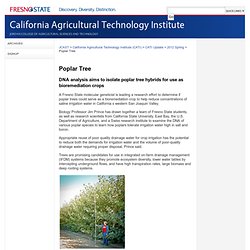
Biology Professor Jim Prince has drawn together a team of Fresno State students, as well as research scientists from California State University, East Bay, the U.S. Department of Agriculture, and a Swiss research institute to examine the DNA of various poplar species to learn how poplars tolerate irrigation water high in salt and boron. Appropriate reuse of poor quality drainage water for crop irrigation has the potential to reduce both the demands for irrigation water and the volume of poor-quality drainage water requiring proper disposal, Prince said. Fresno State student research assistant Danielle Nunez measures a stand of poplar trees growing on the Red Rock Prince expects results and analysis to be completed next year. A_citizens_guide_to_bioremediation.pdf. Bioremediation. The USGS provides maps, reports, and information to help others meet their needs to manage, develop, and protect America's water, energy, mineral, and land resources.
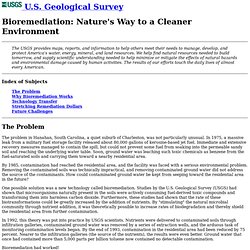
We help find natural resources needed to build tomorrow, and supply scientific understanding needed to help minimize or mitigate the effects of natural hazards and environmental damage caused by human activities. The results of our efforts touch the daily lives of almost every American. Index of Subjects The Problem Why Bioremediation Works Technology Transfer Stretching Remediation Dollars Future Challenges. 89.06.04: Crystals: What Are They and What Holds Them Together. The Three States Of Matter On the earth, matter can exist in three states.
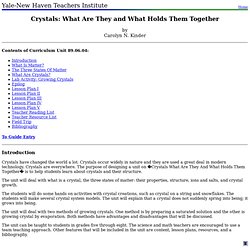
The states of matter are solid, liquid, and gas. A solid has a definite shape. A liquid takes on the shape of its container. A gas does not have a definite volume or a definite shape. Properties of solids. Properties of Solids As you should remember from the kinetic molecular theory, the molecules in solids are not moving in the same manner as those in liquids or gases.
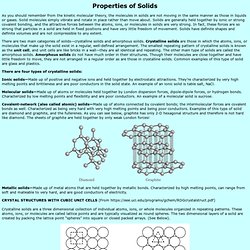
Solid molecules simply vibrate and rotate in place rather than move about. Metals Structure. SPS A - Polymers. Phytoremediation. As both gesture and deed, officials in Fukushima, Japan have this summer sowed sunflower seeds at a city plaza.

Confronting Mercury Contamination in the Environment. Mercury, a notorious heavy metal that poses significant health and environmental threats, is a focus of research at Dartmouth, and Celia Chen, a research professor in the Department of Biological Sciences, recently brought the Dartmouth scientists good news from Geneva, Switzerland.

The illustration “Mercury in the Open Ocean” was taken from the C-MERC publication “Sources to Seafood: Mercury Pollution in the Marine Environment,” December 2012. (Image courtesy of C-MERC) New Wastewater Treatment System Removes Heavy Metals. The presence in the environment of large quantities of toxic metals such as mercury, lead, cadmium, zinc or others, poses serious health risks to humans, and this threat puts the scientific community under pressure to develop new methods to detect and eliminate toxic contaminants from wastewaters in efficient and economically viable ways. Resulting from the combination of water treatment investigations with the latest in material science, a new type of nanomaterial called nanostructured silica has been found to fulfil the requisites necessary for these applications. With its large surface area and regular pores, it is an ideal material that after a functionalization process that links to its surface diverse organic ligands has the capability of being able to extract heavy metals from wastewaters.
The design of this nanostructured functionalized silica is based on the emulation on the material of the reaction that heavy metals have with some biomolecules in living cells. Heavy Metals - Lenntech. Heavy metals are natural components of the Earth's crust.
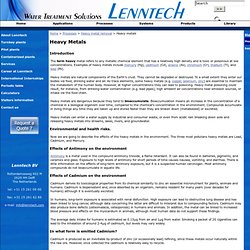
They cannot be degraded or destroyed. To a small extent they enter our bodies via food, drinking water and air. As trace elements, some heavy metals (e.g. copper, selenium, zinc) are essential to maintain the metabolism of the human body. However, at higher concentrations they can lead to poisoning. Heavy metal poisoning could result, for instance, from drinking-water contamination (e.g. lead pipes), high ambient air concentrations near emission sources, or intake via the food chain. Heavy metals are dangerous because they tend to bioaccumulate.
Discovery Guides, A Brief History of Copper. It represents Venus, both the planet and the goddess.

It is the universal symbol for female (♀), and in hieroglyphics is represented by the ankh, which symbolizes eternal life. Pper mining. Introduction. Www.asminternational.org/content/CityOfMaterials/pdfs/5- Brassing a Penny 5.09.10.pdf. Copper mining in the United States. US primary copper production 1900-2008.

Source: USGS US Mines producing copper in 2003 either as a primary or secondary commodity. (Alaska and Hawaii produced no copper in 2003.) Source: USGS. Metal Facts - Interesting Facts about Metals, Alloys, Elements. What is a Metal? Metals are generally defined as being solid elements which share certain physical, chemical and mechanical properties that differentiate them.
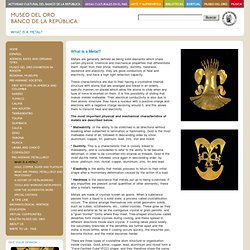
Apart from their shine, malleability, ductility, hardness, resilience and elasticity, they are good conductors of heat and electricity, and have a high light reflection capacity. These characteristics are due to their having a crystalline internal structure with atoms that are arranged and linked in an orderly, specific manner, on planes which allow the atoms to slide when any type of force is exerted on them. It is this possibility of sliding that makes metals malleable. Their electrical conductivity is also due to their atomic structure: they have a nucleus with a positive charge and electrons with a negative charge revolving around it, and this allows them to transmit heat and electricity. Riotintokennecott.com. Environmental Risks of Mining. How they arise and how their effects can be mitigated Overview Unregulated mining has the potential to release harmful substances into the soil, air, and water.
Mission 2016 proposes that governments enforce regulations on companies and use cutting-edge technology to reduce the damage from mining-related sources. As more mines open in countries with varying levels of environmental protection, it is increasingly vital that safeguards established by the Strategic Minerals Association (SMA) are in place before operations proceed (see the international regulation page). Environmental Damages of Mining Open pit mining. What you can do to reduce Mining's Environmental Impacts. There are a number of ways to reduce the environmental impacts of mining, including: Reducing the consumption of minerals People can reduce the consumer goods they use or the content of minerals in manufactured processes can be reduced. For example, instead of building more cars, we could rely more on public transit. The efficiency of manufacturing processes can be increased to reduce the amount of new minerals required For example, structural beams might be designed to be equally strong while using less steel.
Substitution of other materials and processes with more environmentally friendly materials and processes For example, plastics might be used instead of metal to build appliances. Or biomass can be used instead of uranium to produce energy. Secrets of the Samurai Sword. Secrets of the Samurai Sword PBS Airdate: October 9, 2007 NARRATOR: The samurai were the heroes of ancient Japan. Still, today, their legend continues. The samurai's sword is one of the greatest fighting weapons of all time, perfectly engineered for close-up combat, renowned for its deadly cutting edge. Modern science can now reveal the technical excellence of this ancient craft.
MICHAEL NOTIS (Materials Scientist, Lehigh University): It's certainly an object of absolute beauty, from both an aesthetic and a scientific point of view. NARRATOR: But can it explain the mystery of how these swords were made?